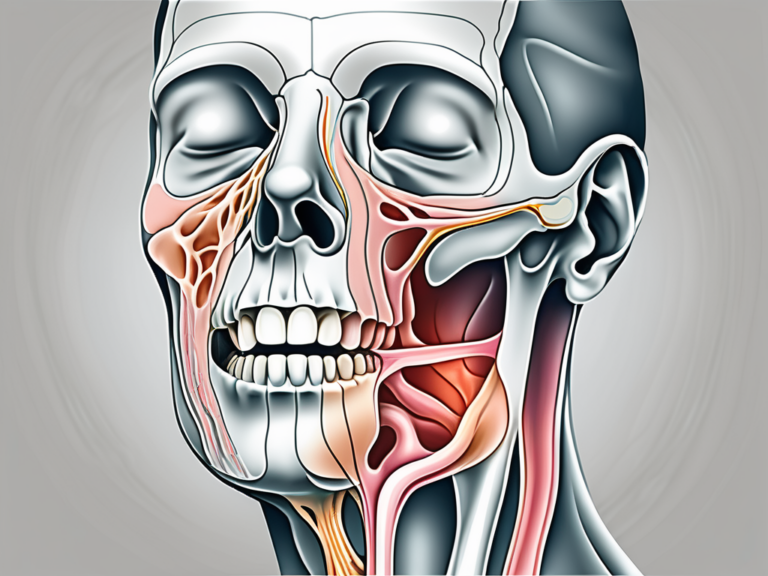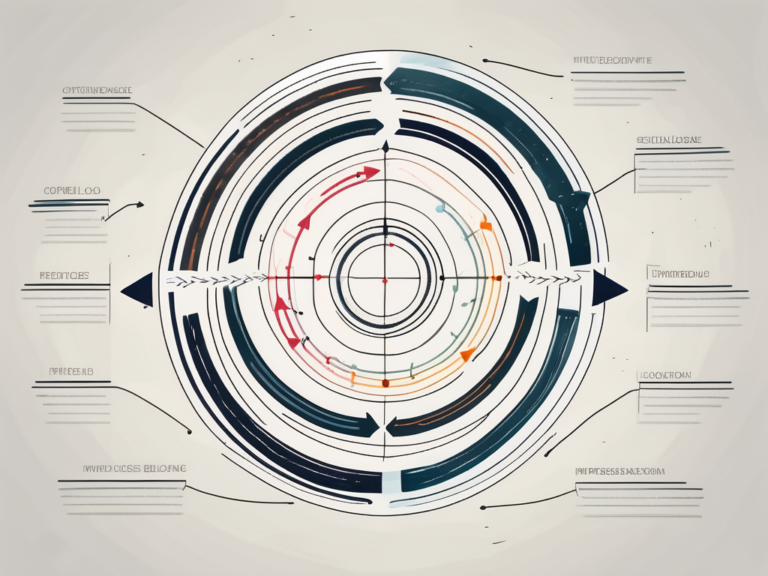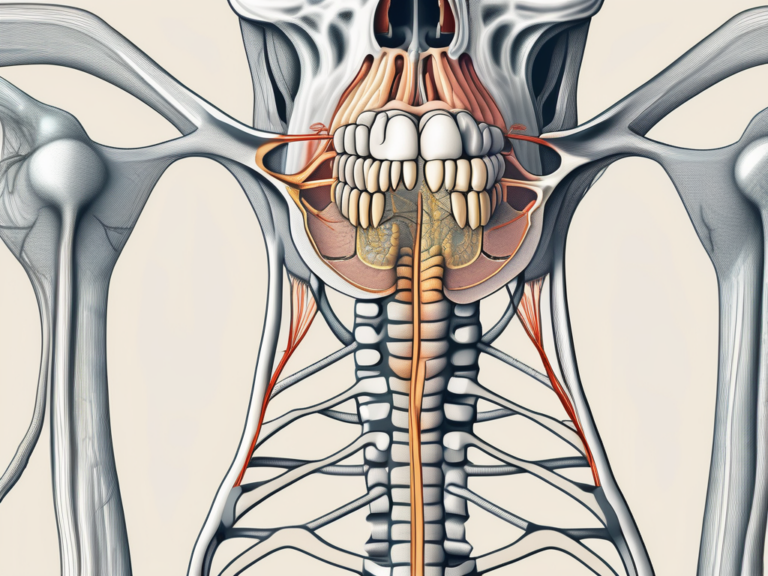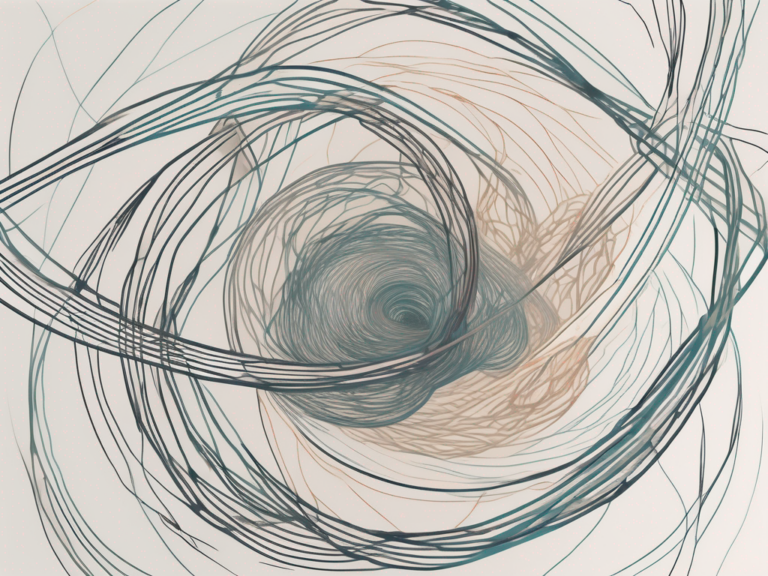Understanding the Abducens Nerve: Functions and Disorders
The abducens nerve is an integral component of the human visual system, playing a crucial role in controlling the movement of the eye. This article aims to provide a comprehensive understanding of the abducens nerve, its functions, and the disorders that can arise when its normal operation is compromised. By delving into the anatomy, functions, common disorders, symptoms and diagnosis, treatment options, and prevention and management strategies, this article aims to shed light on this often overlooked yet significant cranial nerve.
An Overview of the Abducens Nerve
The abducens nerve, also known as cranial nerve VI, is responsible for the lateral movement of the eye. It originates from the pontine portion of the brainstem and innervates the lateral rectus muscle, enabling abduction of the eye. Understanding the anatomy of the abducens nerve is essential to grasp its complex functions.
The abducens nerve is a crucial component of the intricate network of cranial nerves that control eye movements. It plays a significant role in ensuring that the eyes work together harmoniously to provide clear and focused vision. Dysfunction of the abducens nerve can lead to various visual disturbances, such as double vision (diplopia) and difficulty in moving the affected eye laterally.
Anatomy of the Abducens Nerve
The abducens nerve emerges from the inferior portion of the pons and courses through the cavernous sinus, a complex venous structure situated in the middle cranial fossa. Within the cavernous sinus, the abducens nerve lies in close proximity to other cranial nerves, blood vessels, and surrounding structures.
As the abducens nerve travels through the cavernous sinus, it is vulnerable to compression or damage from various pathologies, such as tumors or aneurysms. Any disruption to the abducens nerve’s function can result in ocular misalignment and impact an individual’s ability to focus on objects in their visual field.
The nerve then enters the orbit through the superior orbital fissure before reaching the lateral rectus muscle, providing the necessary innervation for lateral eye movement.
Role of the Abducens Nerve in Vision
Smooth and coordinated eye movements are essential for optimal vision. The abducens nerve assists in ensuring precise horizontal eye movement, enabling an individual to scan the environment, track moving objects, and maintain proper alignment.
In collaboration with other cranial nerves, particularly the oculomotor and trochlear nerves, the abducens nerve contributes to the intricate system responsible for focusing visual attention and maintaining binocular vision.
Delving into the Functions of the Abducens Nerve
Just as a symphony requires perfect coordination between different musical instruments, the human visual system relies on the precise synchronization of various components. The abducens nerve plays a vital role in this intricate coordination, allowing for smooth eye movements and accurate visual perception.
Control of Lateral Eye Movement
The primary function of the abducens nerve is the lateral movement of the eye. Through innervation of the lateral rectus muscle, this cranial nerve enables the eye to move outward, away from the midline of the face. This allows for horizontal gaze and the ability to view objects located on the side without turning the head.
Efficient lateral eye movement is crucial for activities such as reading, driving, and navigating the surroundings. Imagine trying to read a book without being able to smoothly shift your gaze from one word to the next. It would be a frustrating and arduous task, making the simple act of reading a laborious endeavor. Thanks to the abducens nerve, we can effortlessly scan the pages of a book, absorbing knowledge and immersing ourselves in captivating stories.
But the importance of the abducens nerve extends beyond the realm of reading. Consider the experience of driving. As you navigate through traffic, your eyes constantly shift from the road ahead to the side mirrors, ensuring your safety and awareness of the surrounding vehicles. Without the abducens nerve, this fluid motion of glancing from one side to the other would be disrupted, potentially leading to accidents and a compromised driving experience.
Interaction with Other Cranial Nerves
The abducens nerve does not work in isolation but interacts with other cranial nerves to ensure seamless eye movements. This collaboration allows for precise coordination of eye muscles, facilitating smooth tracking of moving objects and maintaining binocular vision.
The oculomotor nerve, for instance, works in concert with the abducens nerve to control most of the eye’s other movements, including elevation, depression, and adduction. Together, these nerves orchestrate the intricate dance of eye movements, allowing us to explore our visual environment with ease and precision.
Now, let’s delve deeper into the role of the trochlear nerve. This cranial nerve contributes to downward eye movement, complementing the actions of the abducens nerve. Picture yourself walking down a flight of stairs. As you descend, your eyes naturally shift downward to ensure each step is taken with confidence and accuracy. This downward eye movement is made possible by the collaboration between the abducens and trochlear nerves, working together to guide your gaze and maintain your balance.
The interplay between these nerves underscores the complexity of the visual system. It is a symphony of coordination, with each cranial nerve playing its unique part to ensure the smooth functioning of our eyes. The abducens nerve, with its control over lateral eye movement, is a key player in this symphony, allowing us to explore the world around us and appreciate the beauty of visual perception.
Common Disorders Affecting the Abducens Nerve
The abducens nerve, like any other component of the human body, is susceptible to various disorders that can significantly impact its functionality. Understanding these disorders is essential for recognizing their symptoms, diagnosing them promptly, and initiating appropriate treatment.
Disorders affecting the abducens nerve can be complex and multifaceted, requiring a comprehensive approach to management and care. In addition to medical interventions, lifestyle modifications and rehabilitative therapies may also play a crucial role in improving outcomes and quality of life for individuals with these conditions.
Abducens Nerve Palsy
Abducens nerve palsy refers to a condition characterized by weakness or paralysis of the lateral rectus muscle, resulting in limited or absent outward eye movement. This can be caused by a variety of factors, including trauma, compression, or inflammation affecting the abducens nerve.
Patients with abducens nerve palsy typically experience double vision, difficulty with horizontal gaze, and an inward deviation of the affected eye. Prompt medical attention and appropriate management are crucial for optimizing visual outcomes in these cases.
Rehabilitation strategies for individuals with abducens nerve palsy may include eye exercises, prism glasses, or surgical interventions to correct muscle alignment. Collaborative care involving ophthalmologists, neurologists, and physical therapists is often necessary to address the complex nature of this disorder and tailor treatment plans to individual needs.
Abducens Nerve Neuritis
Abducens nerve neuritis, also known as sixth cranial nerve optic neuritis, is characterized by inflammation and swelling of the abducens nerve. This condition usually arises due to viral or bacterial infections, autoimmune disorders, or as a result of idiopathic causes.
Individuals with abducens nerve neuritis may experience pain, blurred vision, and restricted lateral eye movements. Early diagnosis and treatment are vital to mitigate the extent of nerve damage and regain visual function.
Management of abducens nerve neuritis may involve a combination of anti-inflammatory medications, corticosteroids, and supportive therapies to reduce inflammation and alleviate symptoms. Close monitoring of visual function and regular follow-up appointments with healthcare providers are essential components of long-term care for individuals affected by this condition.
Symptoms and Diagnosis of Abducens Nerve Disorders
Identifying the signs and symptoms associated with abducens nerve disorders is crucial for early detection and appropriate management. Understanding the diagnostic procedures utilized in the evaluation of these conditions aids healthcare professionals in establishing an accurate diagnosis.
Abducens nerve disorders, also known as sixth cranial nerve palsy, can result from various causes such as head trauma, infections, tumors, or underlying medical conditions like diabetes or hypertension. The abducens nerve is responsible for controlling the lateral rectus muscle, which helps in outward eye movement. Damage to this nerve can lead to a range of ocular symptoms, affecting an individual’s quality of life.
Recognizing the Signs of Abducens Nerve Damage
Common manifestations of abducens nerve disorders include diplopia (double vision) when looking to the affected side, difficulty in abducting the eye past the midline, and an inward deviation of the affected eye. These symptoms may vary in intensity and can significantly impair daily activities.
Clinicians also observe the patient’s eye movements, assess ocular alignment, and conduct additional diagnostic tests to confirm the underlying cause of the abducens nerve dysfunction.
Furthermore, individuals with abducens nerve disorders may experience associated symptoms such as headaches, eye strain, and neck pain due to the extra effort required to compensate for the impaired eye movement. These secondary symptoms can further impact the patient’s overall well-being and may necessitate a multidisciplinary approach to management.
Diagnostic Procedures for Abducens Nerve Disorders
The diagnosis of abducens nerve disorders often involves a comprehensive evaluation, which may include a detailed medical history, thorough physical examination, and specialized imaging studies such as magnetic resonance imaging (MRI) or computed tomography (CT) scans.
Additionally, electromyography (EMG) and nerve conduction studies (NCS) may be employed to assess the electrical activity and functionality of the abducens nerve and associated eye muscles. These tests help in determining the extent of nerve damage and guiding treatment decisions for optimal patient outcomes.
Treatment Options for Abducens Nerve Disorders
The treatment of abducens nerve disorders depends on the underlying cause and the severity of the condition. While there is no universal approach, healthcare professionals employ a combination of medicinal interventions and surgical procedures to manage these disorders effectively.
Abducens nerve disorders can be challenging to treat due to the delicate nature of the nerve and its crucial role in eye movement. The treatment approach often involves a multidisciplinary team of specialists, including neurologists, ophthalmologists, and neurosurgeons, working together to provide comprehensive care tailored to the individual patient’s needs.
Medicinal Interventions
In cases where the abducens nerve dysfunction results from inflammation or infection, anti-inflammatory medications, antibiotics, or antiviral agents may be prescribed. These medications aim to alleviate the underlying cause, reduce nerve swelling, and restore visual function.
Additionally, in some instances, patients may benefit from the use of corticosteroids to help reduce inflammation and improve nerve function. These medications can play a crucial role in managing acute symptoms and preventing long-term complications associated with abducens nerve disorders.
Moreover, other pharmacological interventions, such as pain management and supportive therapies, may be utilized to alleviate associated symptoms and enhance the patient’s overall well-being.
Surgical Procedures
In certain instances, surgical intervention may be necessary to address structural abnormalities or provide decompression of the abducens nerve. Surgical options vary depending on the individual case and may involve techniques such as nerve decompression, muscle realignment, or corrective procedures to enhance ocular alignment.
Surgical procedures for abducens nerve disorders are typically intricate and require a high level of precision to achieve optimal outcomes. Surgeons may utilize advanced imaging techniques, such as intraoperative neuro-navigation, to navigate complex anatomical structures and ensure the accurate placement of surgical instruments.
It is important to note that the decision to proceed with surgery is made on a case-by-case basis, following a thorough assessment of the patient’s specific needs and expected outcomes.
Prevention and Management of Abducens Nerve Disorders
While it may not always be possible to prevent abducens nerve disorders, adopting certain lifestyle modifications can promote better nerve health and reduce the risk of developing related complications.
Lifestyle Modifications for Better Nerve Health
Maintaining a well-balanced diet rich in essential vitamins, minerals, and antioxidants is crucial for optimal nerve function. Including foods such as leafy greens, fruits, whole grains, and lean proteins can provide the necessary nutrients to support nerve health. Additionally, incorporating foods high in omega-3 fatty acids, such as salmon and walnuts, can help reduce inflammation and promote nerve regeneration.
Regular exercise not only benefits overall health but also plays a significant role in maintaining nerve health. Engaging in activities such as walking, swimming, or yoga can improve blood circulation, which is vital for delivering essential nutrients and oxygen to the nerves. Moreover, exercise stimulates the production of endorphins, which can help reduce stress and promote a sense of well-being.
Adequate sleep is essential for the body’s natural healing processes, including nerve repair and regeneration. Aim for seven to eight hours of quality sleep each night to ensure optimal nerve function. Creating a relaxing bedtime routine, such as avoiding electronic devices before bed and practicing relaxation techniques, can help improve sleep quality.
Stress reduction techniques, such as deep breathing exercises, meditation, or engaging in hobbies, can help lower stress levels and reduce the risk of inflammation or compression of the abducens nerve. Chronic stress can negatively impact nerve health, so finding healthy ways to manage stress is crucial.
Avoiding eye strain is essential for maintaining the health of the abducens nerve. Taking regular breaks from activities that require prolonged visual focus, such as working on a computer or reading, can help reduce eye strain. Additionally, practicing proper eye care, such as ensuring proper lighting and using protective eyewear when necessary, can contribute to preserving the integrity of the abducens nerve and the overall visual system.
Promptly addressing any visual abnormalities or discomfort is crucial in preventing further damage to the abducens nerve. If you experience double vision, difficulty moving your eyes, or any other concerning symptoms, it is important to seek medical attention promptly. Early intervention can lead to better outcomes and prevent complications.
Ongoing Care and Monitoring for Abducens Nerve Disorders
Individuals with abducens nerve disorders require ongoing care and monitoring to ensure optimal outcomes. Regular follow-up appointments with healthcare professionals allow for the assessment of treatment efficacy, the identification of potential complications, and the adjustment of management strategies as needed.
During these follow-up appointments, healthcare professionals may perform various tests, such as eye examinations, nerve conduction studies, or imaging scans, to monitor the progression of the abducens nerve disorder and evaluate the effectiveness of the chosen treatment plan. These assessments help guide further management decisions and ensure that the most appropriate interventions are implemented.
It is crucial to follow the advice and recommendations provided by healthcare professionals, attend scheduled appointments, and communicate any changes in symptoms promptly. Proactive involvement in one’s own healthcare is paramount in managing abducens nerve disorders effectively. By actively participating in the treatment process and maintaining open communication with healthcare providers, individuals can optimize their chances of achieving the best possible outcomes.
Conclusion
The abducens nerve, a lesser-known but essential component of the visual system, plays a vital role in maintaining precise eye movements and optimal visual function. Understanding the functions and disorders associated with the abducens nerve is crucial for early recognition, accurate diagnosis, and effective management.
By delving into the anatomy of the abducens nerve, exploring its intricate functions, discussing common disorders, examining symptoms and diagnosis, considering treatment options, and emphasizing prevention and management strategies, this article aimed to provide a comprehensive understanding of this integral cranial nerve.
It is vital to remember that this article is informational and not intended as medical advice. Seeking guidance from healthcare professionals is essential for personalized assessment, accurate diagnosis, and appropriate management of any abducens nerve disorders.






